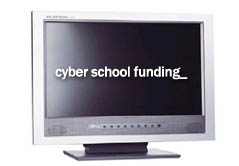Media
Attacking Cyber School Funding
 The House Education Committee held an informational hearing today with administrators from several of Pennsylvania’s cyber schools. The school officials mainly addressed myths about cyber school funding and performance, in light of a new bill introduced by Rep. Michael Fleck in December, HB 1973. One testifier described the bill as “a wolf in sheep’s clothing, purporting to reform charter operations with the true intent of killing cyber charter schools.”
The House Education Committee held an informational hearing today with administrators from several of Pennsylvania’s cyber schools. The school officials mainly addressed myths about cyber school funding and performance, in light of a new bill introduced by Rep. Michael Fleck in December, HB 1973. One testifier described the bill as “a wolf in sheep’s clothing, purporting to reform charter operations with the true intent of killing cyber charter schools.”
Why such strong language? Cyber schools are public, taxpayer-funded online schools that began a decade ago. They offer parents an alternative to their local brick-and-mortar public school, without the cost of a private education. And they are proving immensely popular, with nearly 28,000 students enrolled today. When a student leaves her school district for a cyber school, public funding—76 percent of the per-student cost, on average—follows the child. Faced with a loss of funding—though it is a minuscule 1 percent of public education spending—school districts are crying foul, and demanding that lawmakers “fix” how cyber schools are funded.
The main funding element of HB 1973 is a restriction: It would mandate that cyber schools keep their “fund balances” —essentially the school’s reserves—at 8-12 percent of their budgeted expenditures. Lawrence Jones, President of the Pennsylvania Coalition of Public Charter Schools, explained why this is a problem:
Half of the 400 school districts refuse to pay for their students enrolled in cyber charter schools, forcing cybers into the four-month long redirection process and often into procurement of loans to cover operating costs…Cyber charters need to retain a fund balance so that taxpayer dollars that currently go to lending institutions and attorneys can instead be used to educate children. Imagine what it would be like to run the government if half of Pennsylvania’s taxpayers simply refused to pay their taxes and there were absolutely no recourse to force them to do so.
So, yes: Cyber school officials agree that funding for their schools needs fixing and should be more equitable. But there is no one-size-fits-all “actual instruction expense” for every cyber school. Furthermore, questions such as “How much does it really cost to educate a child?” could equally be asked of a traditional public school.
In reality, having a competitive education marketplace in the form of charter, cyber, private and public schools is what keeps costs down and learning effective. Burdening cyber schools with needless regulation serves only to smother the innovation our public education system so desperately needs. In the end, public education funding should serve children, not a system.